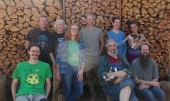
 4
4




 2
2




Invasive plants are Earth's way of insisting we notice her medicines. Stephen Herrod Buhner
Everyone learns what works by learning what doesn't work. Stephen Herrod Buhner
 4
4




 4
4




'What we do now echoes in eternity.' Marcus Aurelius
How Permies Works Dr. Redhawk's Epic Soil Series

 4
4




As a professional landscaper and gardener, I can assure you that honey fungus is not a threat to any annual in your garden, and probably very few woody perrenials.
I have often collected honey mushrooms from spruce stumps around gardens and orchards, and I've never seen any ill effects.
Where I live, it primarily attacks dying spruce trees and their roots and stumps. The mycelium is faintly bioluminescent, and the mushrooms are delicious and easily preserved through drying, although some people may be allergic.
Six species (A. borealis, A. Cepistipes, A. gallica, A. mellea, A. ostoyae and A. tabescens) commonly occur in the UK but of these only two (A. mellea and A. ostoyae) are considered to be pathogens that can infect and kill healthy trees. Identification of the separate species using traditional techniques is very difficult and even the use of modern DNA based methodologies has not lead to the development of a rapid, cost effective assay. This leads to trees often being removed as a precautionary measure on the assumption that the two pathogen species that is present.
How Permies works: https://permies.com/wiki/34193/permies-works-links-threads
My projects on Skye: The tree field, Growing and landracing, perennial polycultures, "Don't dream it - be it! "
 2
2




Anne Miller wrote:welcome to the forum!
I am not familiar with honey fungus though I asked google which said it is destructive in the UK.
It might be good to remove dead wood that has the fungus on it.
It might safely be place in a hot compost pile. It is my understanding that a hot compost will kill pathogens.
I hope some folks with experience will chime in.
 4
4




Megan Palmer wrote:When we lived in the UK, the land around our home was bordered by mature trees and one or two of the older trees had honey fungus in them.
We planted an orchard adjacent to the honey fungus infected trees and as far as I know, the fruit trees are still thriving (we moved back to NZ in 1997 but former neighbours have reported that they are still growing well).
We used to eat them, however only cook a few and make sure that you can tolerate them, some folks get an upset stomach from eating them.
If it is safe, are you able to burn the ground in the vicinity of the affected trees - perhaps set up a steel drum that you can move around to contain the flames and make biochar?
That may help kill the mycelium and stop it spreading further into your garden.
I hope that you manage to contain it.
 4
4




Joylynn Hardesty wrote:Here is an article on the edible Honey Mushrooms. Is this the same fungus you have?
Here is The Mushroom Expert's more scientific guide to identification of Honey Mushrooms.
 1
1





|
Anything worth doing well is worth doing poorly first. Just look at this tiny ad:
The new permaculture playing cards kickstarter is now live!
https://www.kickstarter.com/projects/paulwheaton/garden-cards
|







